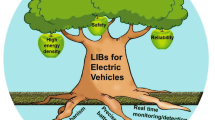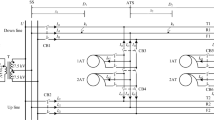Abstract
Metal oxide surge arresters are one of the most important equipment for power system protection against switching and lightning over-voltages. High-energy stresses and environmental features are the main factors which degrade surge arresters. In order to verify surge arresters good condition, their monitoring is necessary. The majority of surge arrester monitoring techniques is based on total leakage current decomposition of their capacitive and resistive components. This paper introduces a new approach based on time-delay addition method to extract the resistive current from the total leakage current without measuring voltage signal. Surge arrester model for calculating leakage current has been performed in ATP–EMTP. In addition, the signal processing has been done using MATLAB software. To show the accuracy of the proposed method, experimental tests have been performed to extract resistive leakage current by the proposed method.









Similar content being viewed by others
References
M. Hasmat, Y.A. Kumar, M. Sukumar et al., Application of neuro-fuzzy scheme to investigate the winding insulation paper deterioration in oil-immersed power transformer, original research article. Int. J. Electr. Power Energy Syst. 53, 256–271 (2013)
B. Vahid, V. Abolfazl, S. Alireza et al., Sweep frequency response analysis for diagnosis of low level short circuit faults on the windings of power transformers: an experimental study. Int. J. Electr. Power Energy Syst. 42, 78–90 (2012)
C.A. Christodouloua, L. Ekonomoub, G.P. Fotis et al., Assessment of surge arrester failure rate and application studies in Hellenic high voltage transmission lines. Electr. Power Syst. Res. 80, 176–183 (2010)
C.A. Christodoulou, M.V. Avgerinos, L. Ekonomou et al., Measurement of the resistive leakage current in surge arresters under artificial rain test and impulse voltage subjection. Sci. Meas. Technol. IET 3(3), 256–262 (2009)
L.T. Coffeen, J.E. McBride, High voltage ac resistive current measurements using a computer based digital watts technique. IEEE Trans. Power Deliv. 6(2), 550–556 (1991)
C. Heinrich, V. Hinrichsen, Diagnostics and monitoring of metal-oxide surge arresters in high-voltage networks-comparison of existing and newly developed procedures. IEEE Trans. Power Deliv. 16(1), 138–143 (2001)
A. Metwally, Performance of distribution-class surge arresters under dry and artificial pollution conditions. Electr. Eng. 93(1), 55–62 (2011)
S. Shirakawa, F. Endo, H. Kitajima et al., Maintenance of surge arrester by a portable arrester leakage current detector. IEEE Trans. Power Deliv. 3(3), 998–1003 (1988)
J. Lundquist, L. Stenstrom, A. Schei, B. Hansen, New method for measurement of the resistive leakage current of metal-oxide surge arresters in service. IEEE Trans. Power Deliv. 5(4), 1811–1822 (1990)
C.A.L. Almeida, A.P. Braga, S. Nascimento et al., Intelligent thermo-graphic diagnostic applied to surge arresters. a new approach. IEEE Trans. Power Deliv. 6, 751–757 (2009)
G.R.S. Lira, E.G. Costa, C.W.D. Almeida, Self-organizing maps applied to monitoring and diagnosis of ZnO surge arresters. In: Transmission and Distribution Conference and Exposition, Latin America (T&D-LA), pp. 659–664 (2010)
E.T.W. Neto, E.G. Costa, M.J.A. Maia, Artificial neural networks used for ZnO arresters diagnosis. IEEE Trans. Power Deliv. 24(3), 1390–1395 (2009)
K.L. Wong, Electromagnetic emission based monitoring technique for polymer ZnO surge arrsters. IEEE Trans. Dielectr. Electr. Insul. 13(1), 181–190 (2006)
X. Jiazhu, A. Kubis, K. Zhou, Y. Zhijun, L.F. Luo, Electromagnetic field and thermal distribution optimization in shell-type traction transformers. Electr. Power Appl. IET 7(8), 627–632 (2013)
C. Karawita, M.R. Raghuveer, Onsite MOSA condition assessment—a new approach. IEEE Trans. Power Del. 21(3), 1273 (2006)
B.-H. Lee, S.-M. Kang, A new on-line leakage current monitoring system of ZnO surge arresters original research. Artic. Mater. Sci. Eng. B 119(1), 13–18 (2005)
Z. Abdul-Malek, F.K. Elektrik, J. Bahru, A. Novizon, A new method to extract the resistive component of the metal oxide surge arrester leakage current. In: Power and Energy Conference, PECon 2008, IEEE 2nd International, pp. 399–402, (2008)
Y.M. Krishna, P. Venkatesh, A new modified shifted current technique to diagnose the surge arrester condition. Int. J. Eng. Res. Technol. (IJERT), 1(8), 1–5 (2012)
Author information
Authors and Affiliations
Corresponding author
Rights and permissions
About this article
Cite this article
Khodsuz, M., Mirzaie, M. A Modified Time-Delay Addition Method to Extract Resistive Leakage Current of MOSA. J. Inst. Eng. India Ser. B 97, 445–451 (2016). https://doi.org/10.1007/s40031-015-0207-3
Received:
Accepted:
Published:
Issue Date:
DOI: https://doi.org/10.1007/s40031-015-0207-3




